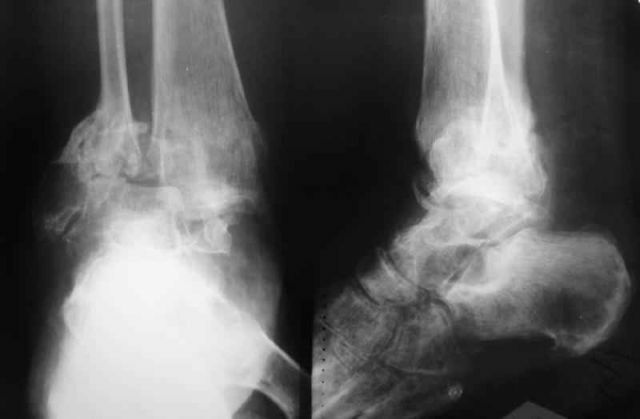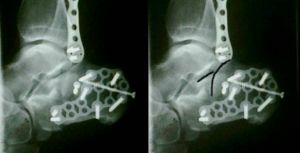 Approximately 10% of all fractures occur on the bones of the shin. In this case, a person may have an open or closed injury.
Approximately 10% of all fractures occur on the bones of the shin. In this case, a person may have an open or closed injury.
In the first case, the integrity of the skin in the affected area is impaired. With the formation of a closed fracture, all the fragments will be inside, while the integrity of the epithelium will not be damaged.
Content of the article
- Anatomical implication
- What causes injury
- Varieties of injuries
- Manifestations of trauma and complaints of the injured
- First aid
- Diagnosis and assistance in the medical institution
- Recovery and rehabilitation after injury
- Possible complications and prevention of trauma
Anatomical overtones
The tibia is called the long andlarge bone of the lower leg. It includes the body and 2 articular ends. The proximal end participates in the formation of the knee joint. The distal part of this bone forms the ankle joint.
The fracture of this part of the leg happens as a result of the influence of a large force. However, it can occur at different levels. Of all the fractures of the musculoskeletal system, this trauma takes about 23%.
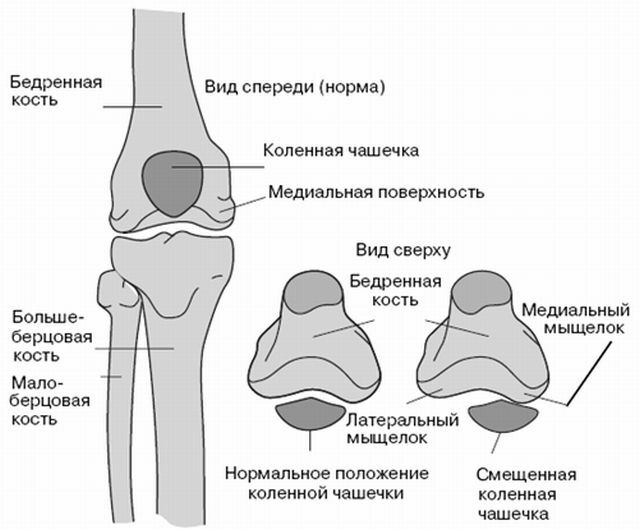
What causes injury to
The main reason for the development of such damage is considered to be high-energy injuries. They include the following:
- traffic accidents;
- falls from height;
- man-made disasters;
- injury in production;
- natural disasters.
This is why the fracture of the tibia is often combined with other injuries - in particular, it may be a fracture of other extremities or ribs, chest damage or abdominal trauma.
To cope with this violation, you should contact a traumatologist.
Varieties of injuries
There are a number of varieties of fractures of the tibia, each of which is characterized by certain features.
So, the following types of fractures are distinguished:
- Stable .In this situation, the displacement of bone fragments is not expressed very strongly. They are localized along the axis. During the
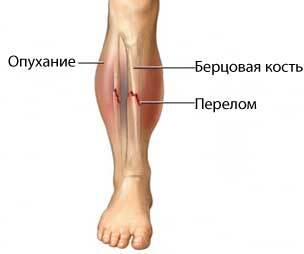 , bone fragments are not displaced.
, bone fragments are not displaced. - Transverse .In this case, the fault line is perpendicular to the axis.
- With offset .With this injury, the axis of the bone is broken, and fragments of bones are also severed. In most cases, this fracture does not grow together, and therefore, an intervention is performed to connect the fragments.
- oblique .In this situation, the fault line is at an angle to the axis. In this case, a person has progressive instability. It is usually combined with a fracture of the tibia.
- Fragmented .When receiving such an injury, the bone breaks down into 3 parts.
- Spiral .In this case, the bone is subjected to the action of twisting force. In this case, the line of injury affects the bone in a spiral.
- Open .In this situation, fragments of bones go beyond the skin. In this case, too, there is a strong damage to the muscle tissue, ligamentous apparatus and tendons. Often, dangerous complications develop. It takes a long time to recover after such damage.
- Closed .At the same time, the integrity of the epithelium is not disturbed, however, serious damage to internal soft tissues can be observed. Often, with such a trauma, a pronounced edema develops, which causes a violation of blood circulation in the limb and leads to the death of muscle cells. In difficult cases, it may be necessary to amputate the legs.
Separate attention deserves a fracture of the condyles of the tibia. By this term is meant the defeat of the lateral zones of the upper part of the bone.
This injury is included in the category of intraarticular fractures that occur with direct bumps or falls on the knee. In this case, displacement or indentation of fragments is often observed.
Manifestations of trauma and complaint of the injured
The following symptoms are usually observed when fracturing the tibia: 
- severe pain syndrome in the area of damage ;
- increase in pain when trying to stand on the foot , while in a relaxed state the discomfort is dull and aching;
- edema in the region of the shin - if the vessels are damaged, the hematoma is formed in the affected area;
- shin deform , the appearance of unnatural leg mobility below the affected area;
- numbness of the foot, pallor of the skin - similar signs indicate damage to nerve fibers and blood vessels;
- lesions of blood vessels and tissues - observed in case of an open fracture.
First aid
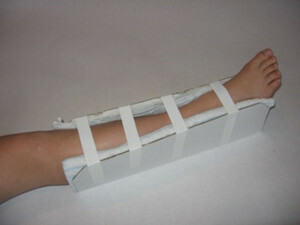 First of all, the victim is given an anesthetic drug and immobilization of the affected limb with a special tire. If there is no such possibility, use the tool-making tools - for example, you can take two boards for this purpose.
First of all, the victim is given an anesthetic drug and immobilization of the affected limb with a special tire. If there is no such possibility, use the tool-making tools - for example, you can take two boards for this purpose.
It is important to ensure that the lower area of the tire covers the ankle, while the upper should reach the upper third of the thigh.
With an open fracture from the skin, you need to remove foreign objects and pollution. It is recommended to close the wound with a sterile bandage. In case of severe bleeding, a tourniquet should be placed on the thigh. If a person has a traumatic shock, he shows anti-shock measures.
Diagnosis and care in a medical institution
To identify a fracture, the physician should examine the external symptoms of the injury and find out the circumstances of the injury.
Of no small importance is the strength and direction of the strike. To get more information, the doctor performs an X-ray of the affected limb. As a rule, it is made in two projections.
The therapy scheme depends on the degree and nature of the injury received. Treatment can be conservative or surgical. With a stable fracture without displacement, immobilization with a plaster bandage is sufficient.
In other situations, the imposition of skeletal traction is shown. In this case, the needle is passed through the bone of the heel, and the limb is placed on the tire. On average, the initial weight for an adult weighs 4-7 kg - this is affected by the patient's body weight, the development of muscle tissue, the nature of the fracture. If necessary, the weight of the load increases or decreases.
Indication for a surgical procedure is a multi-lobed fracture. In this case, it is impossible to restore the correct position of bones by conservative methods. Typically, the operation is performed one week after the person enters the hospital. At this time, the patient's condition is normalized, puffiness decreases, and doctors have time to do a detailed examination.
Surgical treatment of fractures is carried out using a variety of metal structures. These include blocking rods, plates, pins. The choice of a specific technique is affected by the nature and extent of the fracture.
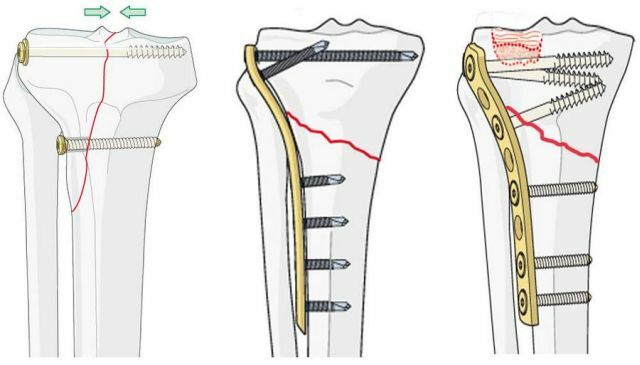
Osteosynthesis of the thigh bone
The fracture fusion period averages 4 months. If a person has an open fracture or a serious injury, this period increases to six months and even more.
Recovery and rehabilitation after injury
To fully recover from such trauma, it is necessary to strictly follow the medical recommendations. Rehabilitation includes the following components:
- Activity of the affected limb should be restored as early as possible. In the period of wearing gypsum, the muscular
 tissue is atrophied, and therefore it needs to be developed. Of course, heavy loads of high intensity are contraindicated in this period, since the bone has not yet had time to grow stronger. It is also important to consider that the load should be increased gradually.
tissue is atrophied, and therefore it needs to be developed. Of course, heavy loads of high intensity are contraindicated in this period, since the bone has not yet had time to grow stronger. It is also important to consider that the load should be increased gradually. - Massage also brings certain benefits, because it helps warm up the muscle tissue. In addition, it has a positive effect on blood circulation. Due to this, the bones receive the necessary substances and are quickly strengthened.
- Sometimes doctors prescribe physiotherapy tools .Thanks to these techniques, it is possible to improve nutrition of affected tissues and to stimulate regeneration processes.
- Therapeutic exercises of should be performed under the supervision of a specialist. First passive development of the shin is carried out. After that, the person begins to lift his legs and do squats.
- To stimulate the process of bone fusion, is very important to fully eat and take vitamin preparations .
Possible complications and prevention of trauma
After a fracture, such complications can develop:
- complete loss of motor activity after a long immobilization;
- development of degenerative arthrosis;
- infection at an open fracture;
- lesion of the neurovascular bundle.
 To prevent fracture of the tibia, it is recommended to avoid various damages. If a person is engaged in active sports, be sure to use personal protective equipment.
To prevent fracture of the tibia, it is recommended to avoid various damages. If a person is engaged in active sports, be sure to use personal protective equipment.
Fracture of the tibia is a serious enough injury that can lead to the development of dangerous complications. To prevent this from happening, you need to consult a doctor in time and clearly follow all the recommendations of a specialist.
Special attention should also be given to the rehabilitation period, which will allow to completely restore the motor activity.


